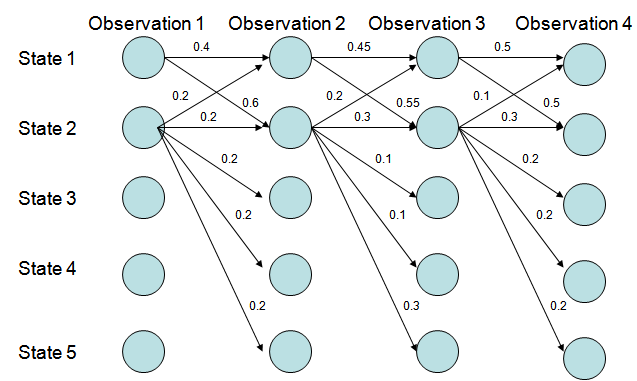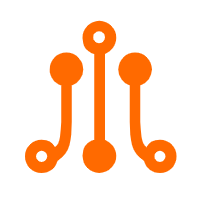This article presents a comparison analysis of Hidden Markov Model (HMM), Maximum Entropy Markov Models (MEMM), and Conditional Random Fields (CRF). HMM, MEMM, and CRF are three popular statistical modeling methods, often applied to pattern recognition and machine learning problems. Let us explore each method in further detail.
The word “Hidden” symbolizes the fact that only the symbols released by the system are observable, while the user cannot view the underlying random walk between states. Many in this field recognize HMM as a finite state machine.

Hidden Markov Model (HMM)
Advantages of HMM
HMM has a strong statistical foundation with efficient learning algorithms where learning can take place directly from raw sequence data. It allows consistent treatment of insertion and deletion penalties in the form of locally learnable methods and can handle inputs of variable length. They are the most flexible generalization of sequence profiles. It can also perform a wide variety of operations including multiple alignment, data mining and classification, structural analysis, and pattern discovery. It is also easy to combine into libraries.
Disadvantages of HMM
The sequence labeling, in addition to having a relationship with individual words, also relates to such aspects as the observed sequence length, word context and others.

Maximum Entropy Markov Models
MEMM takes into account the dependencies between neighboring states and the entire observed sequence, hence a better expression ability. MEMM does not consider P(X), which reduces the modeling workload and learns the consistency between the target function and the estimated function.

Viterbi algorithm decoding of MEMM
In Figure 3, State 1 tends to convert to State 2, and State 2 tends to stay at State 2 at the same time.
P(1-> 1-> 1-> 1)= 0.4 x 0.45 x 0.5 = 0.09, P(2->2->2->2)= 0.2 X 0.3 X 0.3 = 0.018,
P(1->2->1->2)= 0.6 X 0.2 X 0.5 = 0.06,P(1->1->2->2)= 0.4 X 0.55 X 0.3 = 0.066.
However, the optimal state conversion path is 1 > 1 > 1 >1. Why?
It is because State 2 has more convertible states than State 1 does, hence reducing the conversion probability – MEMM tends to select the state with fewer convertible states. Such selection is termed the labeling bias issue. CRF well addresses the labeling bias issue.

The CRF model has addressed the labeling bias issue and eliminated two unreasonable hypotheses in HMM. Of course, the model has also become more complicated.
MEMM adopts local variance normalization while CRF adopts global variance normalization.
On the other hand, MEMMs cannot find the corresponding parameters to meet the following distribution:
a b c --> a/A b/B c/C p(A B C | a b c) = 1
a b e --> a/A b/D e/E p(A D E | a b e) = 1
p(A|a)p(B|b,A)p(C|c,B) = 1
p(A|a)p(D|b,A)p(E|e,D) = 1
But CRFs can.
Generative model or discriminative model
Suppose o is the observed value, and m is the model.
a) Generative model: Infinite samples > Probability density model = Generative model > Prediction
If you model P(o|m), it is a generative model. The basic idea is, first, to establish the probability density model of the sample, and then use the model for inference prediction. The requirement of the samples being infinite or as large as possible is common knowledge. The method draws from statistical mechanics and Bayes theory.
HMM directly models the transition probability and phenotype probability, and calculates the probability of co-occurrence. Thus, it is a generative model.
b) Discriminative model: Finite samples > Discriminative function = Discriminative model > Prediction
If you model on the conditional probability P(m|o), it is the discriminative model. The basic idea is to establish the discriminant function with finite samples, and directly study the prediction model without considering the generative model of samples. Its representative theory is the statistical learning theory.
CRF is a discriminant model. MEMM is not a generative model, but a model with finite states based on state classification.
Topological structure
HMM and MEMM are a directed graph, while CRF is an undirected graph.
Global optimum or local optimum
HMM directly models the transition probability and the phenotype probability, and calculates the probability of co-occurrence.
MEMM establishes the probability of co-occurrence based on the transition probability and the phenotype probability. It calculates the conditional probability, and only adopts the local variance normalization, making it easy to fall into a local optimum.
CRF calculates the normalization probability in the global scope, rather than in the local scope as is the case with MEMM. It is an optimal global solution and resolves the labeling bias issue in MEMM.
Advantages and Disadvantages of CRF
Advantages
Disadvantages
CRF is highly computationally complex at the training stage of the algorithm. It makes it very difficult to re-train the model when newer data becomes available.
This post detailed out a comparative analysis between Hidden Markov Model (HMM), Maximum Entropy Markov Models (MEMM), and Conditional Random Fields (CRF). In this post we categorically learnt that CRFs and MEMMS are mainly discriminative sequence models whereas HMMs are primarily generative sequence models. It is Bayes Rule that forms the basis of HMM. On the contrary, CRF and MEMM’s based on MaxEnt models over transition and observable features.

2,597 posts | 772 followers
FollowAlibaba Clouder - May 25, 2017
Alibaba Clouder - February 6, 2018
Alibaba Clouder - February 1, 2021
Alibaba Clouder - May 6, 2020
Alibaba Clouder - September 5, 2018
Alibaba Clouder - March 8, 2017

2,597 posts | 772 followers
Follow Big Data Consulting for Data Technology Solution
Big Data Consulting for Data Technology Solution
Alibaba Cloud provides big data consulting services to help enterprises leverage advanced data technology.
Learn More Big Data Consulting Services for Retail Solution
Big Data Consulting Services for Retail Solution
Alibaba Cloud experts provide retailers with a lightweight and customized big data consulting service to help you assess your big data maturity and plan your big data journey.
Learn More ApsaraDB for HBase
ApsaraDB for HBase
ApsaraDB for HBase is a NoSQL database engine that is highly optimized and 100% compatible with the community edition of HBase.
Learn More Platform For AI
Platform For AI
A platform that provides enterprise-level data modeling services based on machine learning algorithms to quickly meet your needs for data-driven operations.
Learn MoreMore Posts by Alibaba Clouder